2009 Hyundai Sonata wheel
[x] Cancel search: wheelPage 10 of 286

F9
1. Door lock/unlock button
2. Outside rearview mirror control switch*
3. Central door lock switch*
4. Power window lock switch*
5. Power window switches*
6. Trunk lid release lever
7. Fuel filler lid opener button
8. Panel Brightness Control Knob (Rheostat Switch)
9. Electronic Stability Control (ESC) Switch
CAUTION:
When installing a container of liquid air freshener inside the vehicle, do not place it near the instrument cluster
nor on the instrument panel surface. If there is any leakage from the air freshener onto these areas
(Instrument cluster, instrument panel or air ventilator), it may damage these parts. If the liquid from the air
freshener does leak onto these areas, wash them with water immediately.
!
10. Power Adjustable Pedals Switch*
11. Steering wheel tilt
12. Hood release lever
13. Brake pedal
14. Accelerator pedal
15. Clutch pedal*
16. Fuse box
* : if installed
Page 30 of 286

1
FEATURES OF YOUR HYUNDAI
17
B080E01Y-AATLumbar Support Control
(Driver's Seat Only) (If Installed)To adjust the lumbar support, turn the
handle on the outboard or left side of the
seat. To increase the amount of lumbar
support, pull the lever forward. To decrease
it, push the lever toward the rear.
1. Minimum support
2. Maximum support
ONF038006
2
!
B090A02Y-AATPOWER DRIVER'S SEAT (If Installed)The driver's seat can be adjusted by using
the control knobs on the left side of the seat.
Before driving, adjust the seat to the proper
position so as to easily control the steering
wheel, pedals and switches on the
instrument panel.
CAUTION:
Do not operate two knobs at the same
time.
WARNING:
o Never adjust a driver’s seat while the
vehicle is moving. Any sudden or
unexpected movement of the seat
could cause you to lose control of the
vehicle resulting in an accident. Only
adjust the driver’s seat when the
vehicle is stationary.
o Do not sit or lean unnecessarily close
to the airbag. Position the seat so that
you can sit as far back as possible
from the airbag and still comfortably
reach all controls.
!
B080F01NF-GATSeat Height Adjustment
(Driver's Seat Only)To raise or lower the seat, raise or lower the
control lever to the desired seat height.
ONF038004
1
Page 48 of 286
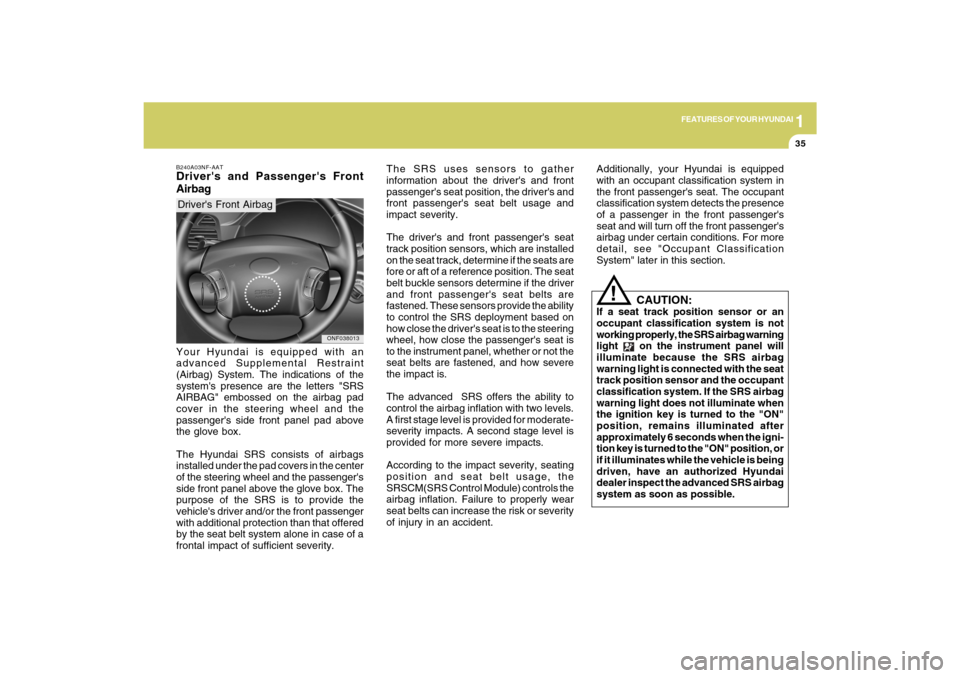
1
FEATURES OF YOUR HYUNDAI
35
The SRS uses sensors to gather
information about the driver's and front
passenger's seat position, the driver's and
front passenger's seat belt usage and
impact severity.
The driver's and front passenger's seat
track position sensors, which are installed
on the seat track, determine if the seats are
fore or aft of a reference position. The seat
belt buckle sensors determine if the driver
and front passenger's seat belts are
fastened. These sensors provide the ability
to control the SRS deployment based on
how close the driver's seat is to the steering
wheel, how close the passenger's seat is
to the instrument panel, whether or not the
seat belts are fastened, and how severe
the impact is.
The advanced SRS offers the ability to
control the airbag inflation with two levels.
A first stage level is provided for moderate-
severity impacts. A second stage level is
provided for more severe impacts.
According to the impact severity, seating
position and seat belt usage, the
SRSCM(SRS Control Module) controls the
airbag inflation. Failure to properly wear
seat belts can increase the risk or severity
of injury in an accident.
CAUTION:
If a seat track position sensor or an
occupant classification system is not
working properly, the SRS airbag warning
light
on the instrument panel will
illuminate because the SRS airbag
warning light is connected with the seat
track position sensor and the occupant
classification system. If the SRS airbag
warning light does not illuminate when
the ignition key is turned to the "ON"
position, remains illuminated after
approximately 6 seconds when the igni-
tion key is turned to the "ON" position, or
if it illuminates while the vehicle is being
driven, have an authorized Hyundai
dealer inspect the advanced SRS airbag
system as soon as possible.
!
Additionally, your Hyundai is equipped
with an occupant classification system in
the front passenger's seat. The occupant
classification system detects the presence
of a passenger in the front passenger's
seat and will turn off the front passenger's
airbag under certain conditions. For more
detail, see "Occupant Classification
System" later in this section.
B240A03NF-AATDriver's and Passenger's Front
AirbagYour Hyundai is equipped with an
advanced Supplemental Restraint
(Airbag) System. The indications of the
system's presence are the letters "SRS
AIRBAG" embossed on the airbag pad
cover in the steering wheel and the
passenger's side front panel pad above
the glove box.
The Hyundai SRS consists of airbags
installed under the pad covers in the center
of the steering wheel and the passenger's
side front panel above the glove box. The
purpose of the SRS is to provide the
vehicle's driver and/or the front passenger
with additional protection than that offered
by the seat belt system alone in case of a
frontal impact of sufficient severity.Driver's Front Airbag
ONF038013
Page 50 of 286
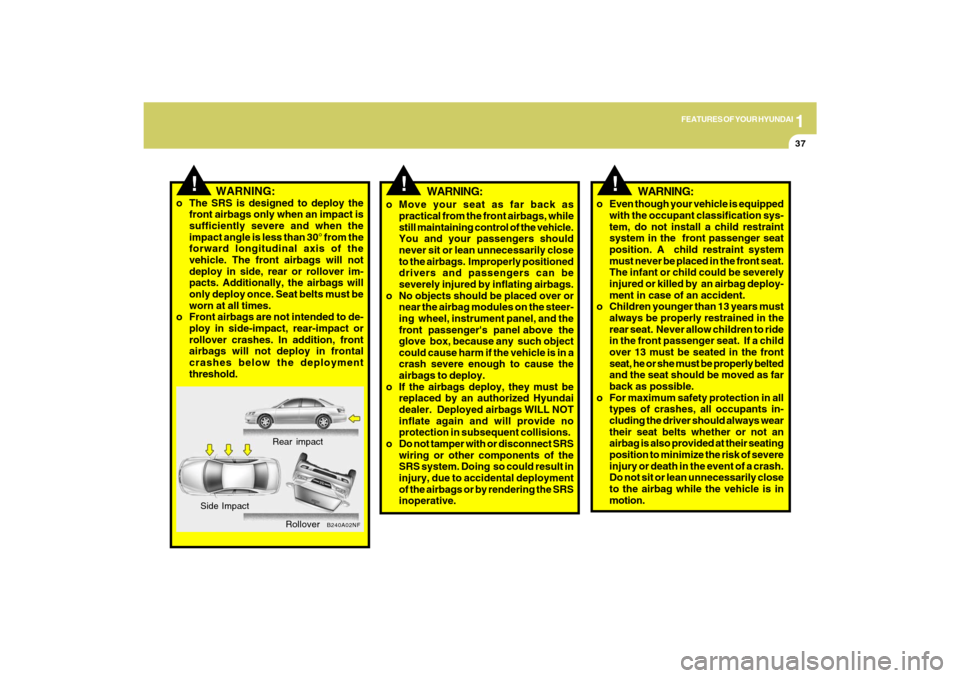
1
FEATURES OF YOUR HYUNDAI
37
!
WARNING:
o Move your seat as far back as
practical from the front airbags, while
still maintaining control of the vehicle.
You and your passengers should
never sit or lean unnecessarily close
to the airbags. Improperly positioned
drivers and passengers can be
severely injured by inflating airbags.
o No objects should be placed over or
near the airbag modules on the steer-
ing wheel, instrument panel, and the
front passenger's panel above the
glove box, because any such object
could cause harm if the vehicle is in a
crash severe enough to cause the
airbags to deploy.
o If the airbags deploy, they must be
replaced by an authorized Hyundai
dealer. Deployed airbags WILL NOT
inflate again and will provide no
protection in subsequent collisions.
o Do not tamper with or disconnect SRS
wiring or other components of the
SRS system. Doing so could result in
injury, due to accidental deployment
of the airbags or by rendering the SRS
inoperative.
!
WARNING:
o The SRS is designed to deploy the
front airbags only when an impact is
sufficiently severe and when the
impact angle is less than 30° from the
forward longitudinal axis of the
vehicle. The front airbags will not
deploy in side, rear or rollover im-
pacts. Additionally, the airbags will
only deploy once. Seat belts must be
worn at all times.
o Front airbags are not intended to de-
ploy in side-impact, rear-impact or
rollover crashes. In addition, front
airbags will not deploy in frontal
crashes below the deployment
threshold.
!
WARNING:
o Even though your vehicle is equipped
with the occupant classification sys-
tem, do not install a child restraint
system in the front passenger seat
position. A child restraint system
must never be placed in the front seat.
The infant or child could be severely
injured or killed by an airbag deploy-
ment in case of an accident.
o Children younger than 13 years must
always be properly restrained in the
rear seat. Never allow children to ride
in the front passenger seat. If a child
over 13 must be seated in the front
seat, he or she must be properly belted
and the seat should be moved as far
back as possible.
o For maximum safety protection in all
types of crashes, all occupants in-
cluding the driver should always wear
their seat belts whether or not an
airbag is also provided at their seating
position to minimize the risk of severe
injury or death in the event of a crash.
Do not sit or lean unnecessarily close
to the airbag while the vehicle is in
motion.
B240A02NF
Rear impact
Side Impact
Rollover
Page 52 of 286
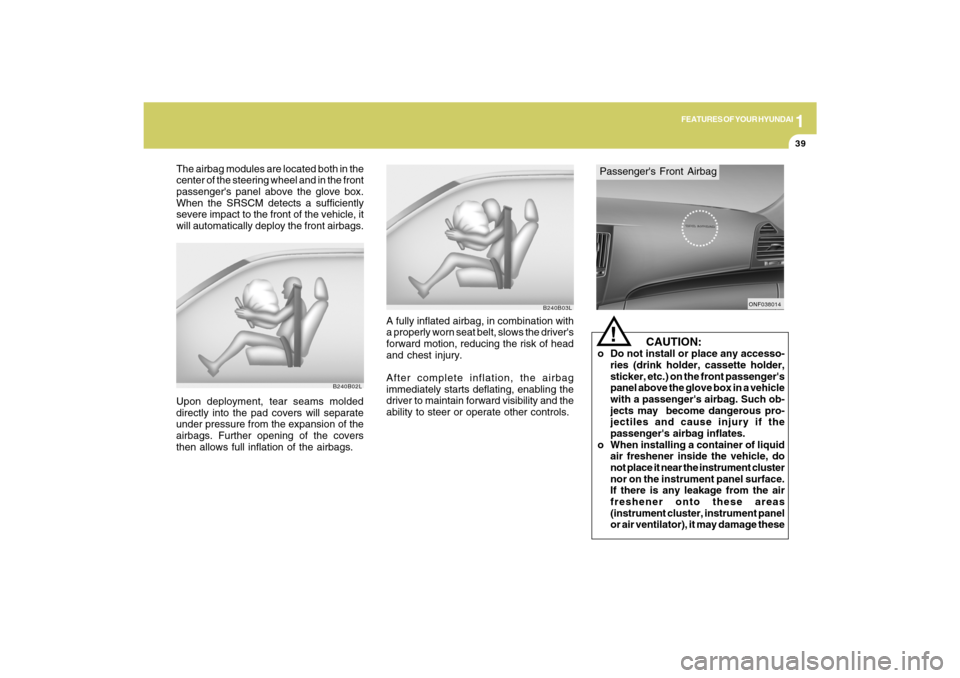
1
FEATURES OF YOUR HYUNDAI
39
B240B02L
Upon deployment, tear seams molded
directly into the pad covers will separate
under pressure from the expansion of the
airbags. Further opening of the covers
then allows full inflation of the airbags.A fully inflated airbag, in combination with
a properly worn seat belt, slows the driver's
forward motion, reducing the risk of head
and chest injury.
After complete inflation, the airbag
immediately starts deflating, enabling the
driver to maintain forward visibility and the
ability to steer or operate other controls.
B240B03L
The airbag modules are located both in the
center of the steering wheel and in the front
passenger's panel above the glove box.
When the SRSCM detects a sufficiently
severe impact to the front of the vehicle, it
will automatically deploy the front airbags.
CAUTION:
o Do not install or place any accesso-
ries (drink holder, cassette holder,
sticker, etc.) on the front passenger's
panel above the glove box in a vehicle
with a passenger's airbag. Such ob-
jects may become dangerous pro-
jectiles and cause injury if the
passenger's airbag inflates.
o When installing a container of liquid
air freshener inside the vehicle, do
not place it near the instrument cluster
nor on the instrument panel surface.
If there is any leakage from the air
freshener onto these areas
(instrument cluster, instrument panel
or air ventilator), it may damage these
!
ONF038014
Passenger's Front Airbag
Page 58 of 286

1
FEATURES OF YOUR HYUNDAI
45
!
o For best protection from the side im-
pact airbag system and to avoid being
injured by the deploying side impact
airbag, both front seat occupants
should sit in an upright position with
the seat belt properly fastened. The
driver's hands should be placed on
the steering wheel at the 9:00 and
3:00 positions. The passenger's arms
and hands should be placed on their
laps.
o Do not use any accessory seat covers.
o Use of seat covers could reduce or
prevent the effectiveness of the sys-
tem.
o Do not install any accessories on the
side or near the side impact airbag.
o Do not place any objects over the
airbag or between the airbag and
yourself.
o Do not place any objects (an umbrella,
bag, etc.) between the front door and
the front seat. Such objects may be-
come dangerous projectiles and
cause injury if the supplemental side
impact airbag inflates.
o To prevent unexpected deployment
of the side impact airbag that may
result in personal injury, avoid impact
to the side impact sensor when the
ignition key is on.
WARNING:
WARNING:
o The side impact airbag is
supplemental to the driver's and the
passenger's seat belt systems and is
not a substitute for them. Therefore
your seat belts must be worn at all
times while the vehicle is in motion.
The airbags deploy only in certain
side impact conditions severe enough
to cause significant injury to the
vehicle occupants.
!
ONF038022
Side impact
sensor
B990C01LZ-GATCurtain AirbagCurtain airbags are located along both
sides of the roof rails above the front and
rear doors.
They are designed to help protect the
heads of the front seat occupants and the
rear outboard seat occupants in certain
side impact collisions.
The curtain airbags are designed to deploy
only during certain side impact collisions,
depending on the crash severity, angle,
speed and impact. The curtain airbags are
not designed to deploy in all side impact
situations, collisions from the front or rear
of the vehicle or in most rollover situations.
HLZ2051
Curtain Airbag
Page 59 of 286
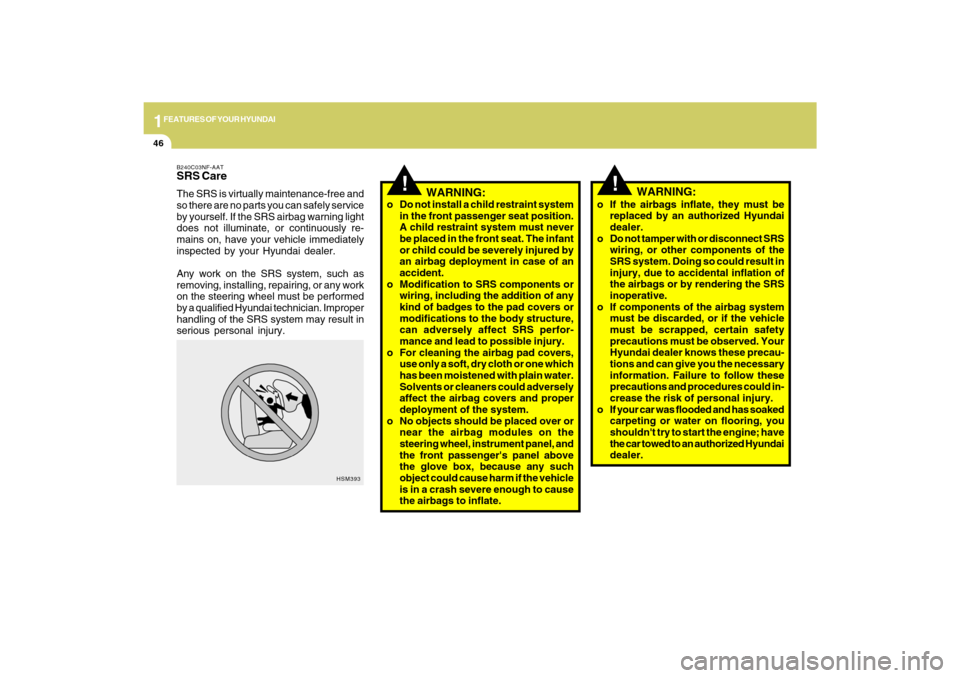
1FEATURES OF YOUR HYUNDAI46
o If the airbags inflate, they must be
replaced by an authorized Hyundai
dealer.
o Do not tamper with or disconnect SRS
wiring, or other components of the
SRS system. Doing so could result in
injury, due to accidental inflation of
the airbags or by rendering the SRS
inoperative.
o If components of the airbag system
must be discarded, or if the vehicle
must be scrapped, certain safety
precautions must be observed. Your
Hyundai dealer knows these precau-
tions and can give you the necessary
information. Failure to follow these
precautions and procedures could in-
crease the risk of personal injury.
o If your car was flooded and has soaked
carpeting or water on flooring, you
shouldn't try to start the engine; have
the car towed to an authorized Hyundai
dealer.
!
WARNING:
B240C03NF-AATSRS CareThe SRS is virtually maintenance-free and
so there are no parts you can safely service
by yourself. If the SRS airbag warning light
does not illuminate, or continuously re-
mains on, have your vehicle immediately
inspected by your Hyundai dealer.
Any work on the SRS system, such as
removing, installing, repairing, or any work
on the steering wheel must be performed
by a qualified Hyundai technician. Improper
handling of the SRS system may result in
serious personal injury.
WARNING:
o Do not install a child restraint system
in the front passenger seat position.
A child restraint system must never
be placed in the front seat. The infant
or child could be severely injured by
an airbag deployment in case of an
accident.
o Modification to SRS components or
wiring, including the addition of any
kind of badges to the pad covers or
modifications to the body structure,
can adversely affect SRS perfor-
mance and lead to possible injury.
o For cleaning the airbag pad covers,
use only a soft, dry cloth or one which
has been moistened with plain water.
Solvents or cleaners could adversely
affect the airbag covers and proper
deployment of the system.
o No objects should be placed over or
near the airbag modules on the
steering wheel, instrument panel, and
the front passenger's panel above
the glove box, because any such
object could cause harm if the vehicle
is in a crash severe enough to cause
the airbags to inflate.
!
HSM393
Page 65 of 286
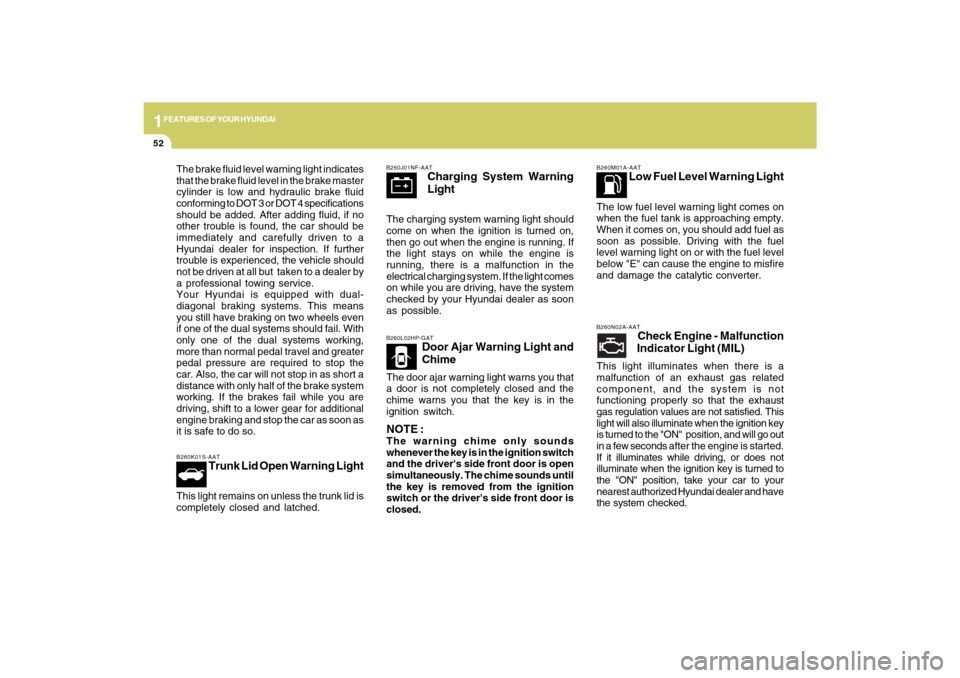
1FEATURES OF YOUR HYUNDAI52
B260L02HP-GAT
Door Ajar Warning Light and
Chime
The door ajar warning light warns you that
a door is not completely closed and the
chime warns you that the key is in the
ignition switch.NOTE :The warning chime only sounds
whenever the key is in the ignition switch
and the driver's side front door is open
simultaneously. The chime sounds until
the key is removed from the ignition
switch or the driver's side front door is
closed.
B260M01A-AAT
Low Fuel Level Warning Light
The low fuel level warning light comes on
when the fuel tank is approaching empty.
When it comes on, you should add fuel as
soon as possible. Driving with the fuel
level warning light on or with the fuel level
below "E" can cause the engine to misfire
and damage the catalytic converter.B260N02A-AAT
Check Engine - Malfunction
Indicator Light (MIL)
This light illuminates when there is a
malfunction of an exhaust gas related
component, and the system is not
functioning properly so that the exhaust
gas regulation values are not satisfied. This
light will also illuminate when the ignition key
is turned to the "ON" position, and will go out
in a few seconds after the engine is started.
If it illuminates while driving, or does not
illuminate when the ignition key is turned to
the "ON" position, take your car to your
nearest authorized Hyundai dealer and have
the system checked. The brake fluid level warning light indicates
that the brake fluid level in the brake master
cylinder is low and hydraulic brake fluid
conforming to DOT 3 or DOT 4 specifications
should be added. After adding fluid, if no
other trouble is found, the car should be
immediately and carefully driven to a
Hyundai dealer for inspection. If further
trouble is experienced, the vehicle should
not be driven at all but taken to a dealer by
a professional towing service.
Your Hyundai is equipped with dual-
diagonal braking systems. This means
you still have braking on two wheels even
if one of the dual systems should fail. With
only one of the dual systems working,
more than normal pedal travel and greater
pedal pressure are required to stop the
car. Also, the car will not stop in as short a
distance with only half of the brake system
working. If the brakes fail while you are
driving, shift to a lower gear for additional
engine braking and stop the car as soon as
it is safe to do so.
B260J01NF-AAT
Charging System Warning
Light
The charging system warning light should
come on when the ignition is turned on,
then go out when the engine is running. If
the light stays on while the engine is
running, there is a malfunction in the
electrical charging system. If the light comes
on while you are driving, have the system
checked by your Hyundai dealer as soon
as possible.
B260K01S-AAT
Trunk Lid Open Warning Light
This light remains on unless the trunk lid is
completely closed and latched.